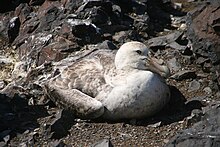Giant petrel
| Giant petrel | ||||||||||
|---|---|---|---|---|---|---|---|---|---|---|

Giant Petrel ( Macronectes giganteus ) |
||||||||||
| Systematics | ||||||||||
|
||||||||||
| Scientific name | ||||||||||
| Macronectes giganteus | ||||||||||
| ( Gmelin , 1789) |

The giant petrel ( Macronectes giganteus ) is a breeding bird of the Antarctic mainland and many sub-Antarctic islands from the petrel family (Procellariidae). He spends his life mostly on the high seas and can then be found up to the Tropic of Capricorn.
It belongs to the petrel family . Another name is the southern giant petrel . Seafarers call the birds - like the hall petrels - “stinkers” because they vomit a strong-smelling, oily stomach contents when they are frightened. This enables you to get into the air faster.
In contrast to the closely related Hall petrel, the giant petrel breeds in colonies.
Appearance
The giant petrel reaches a wing span of up to 200 cm and a body length of 84 to 92 cm. Its plumage is dark gray-brown, which is noticeably lighter in color on the head, neck and throat. Giant petrels are easily recognizable by their huge, horned-plate beak with its elongated double nasal tube ( tubular noses ). The small, light eyes are surrounded by a spring wheel, the color of the feet ranges from brown to smoky black.
Compared to the albatross , their flight appears to be more awkward, as they flutter not very elegantly or glide along in a stiff-winged posture with the head held low. Giant petrels are scavengers , they feed on dead marine animals that swim on the surface of the sea, but also on young or weak penguins and their eggs. They often follow ships in search of waste.
Distribution area
The giant petrel has a circumpolar distribution area. It breeds on South Georgia, the Prince Edward Islands , Crozet Islands , the Kerguelen and Macquarie Island . The breeding area also includes the Antarctic Peninsula and islands off the coast of the Argentine province of Chubut . Breeding sites can also be found on the Diego Ramírez Islands and Isla Noir off Chile and on the Tristan da Cunha archipelago . A large part of the world's population breeds in the Falkland Islands .
Way of life
Giant petrels breed in loose colonies on flat ground near the coast. The nest is a shallow hollow. The clutch consists of an egg that is incubated for about two months. Fledglings fledge at four months of age.
Others
The in English also Break Bones ( Bonecrusher birds mentioned) are named after the Break Bones plateau on Candlemas Iceland in the archipelago of the South Sandwich Islands.
supporting documents
literature
- Robin and Anne Woods: Atlas of Breeding Birds of the Falkland Islands , Anthony Nelson, Shorpshire 1997, ISBN 0-904614-60-3
Individual evidence
- ↑ Wood, p. 48
Web links
- Videos, photos and sound recordings on Macronectes giganteus in the Internet Bird Collection
- Macronectes giganteus in the endangered Red List species the IUCN 2012. Posted by: BirdLife International, 2012. Accessed November 17, 2012th
- Giant petrel feathers

